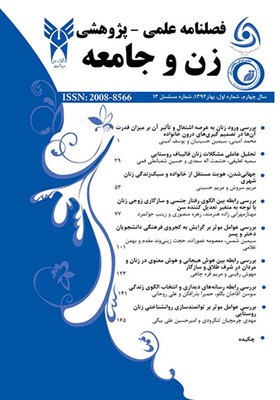مرور نظاممند عوامل زمینهساز طلاق توافقی زوجین دهه اخیر در ایران (98 - 1388)
محورهای موضوعی : زن و جامعه
لقمان ابراهیمی
1
*
![]() ,
مریم محمدلو
2
,
مریم محمدلو
2
1 - زنجان، بلوار دانشگاه، دانشگاه زنجان دانشکده علوم انسانی گروه روانشناسی اتاق 308
2 - دانشجوی دکتری روانشناسی، دانشگاه آزاد اسلامی واحد سمنان
کلید واژه: طلاق, طلاق توافقی, مرور نظاممند,
چکیده مقاله :
پژوهش حاضر باهدف شناسایی عوامل زمینهساز طلاق توافقی به شیوه مرور نظاممند صورت گرفته است. جهت گردآوری دادهها از روشتحلیل اسنادی استفاده گردید، جمعیت مورد مطالعه پژوهش شامل تمامی تحقیقات کمّی و کیفی منتشرشده (1398-1388)بود و جمعاً 192 پژوهش کمّی و کیفی مورد بررسی قرار گرفت و از این تعداد،56 پژوهش بهعنوان حجم نمونه انتخاب شد. اطلاعات بهدستآمده با ابزار چکلیست محقق ساخته و تلخیص مطالب در قالب جداول ارائه شد. یافتهها نشان داد: سه دسته عوامل بهعنوان زمینه ساز طلاق توافقی با عنوان فردی، بین فردی و فرا فردی نقش دارند، بدین ترتیب که در ابعاد فردی، به ترتیب عوامل ویژگیهای شخصیتی و روانی(بیماریهای روانی، چشموهمچشمی، ضرب و شتم،دروغگویی،سوءظن و بدبینی،خیانت، خشونت اخلاقی و رفتاری، عدم صبر و گذشت، تصویر مثبت از پیامدهای طلاق، منبع کنترل و تابآوری، آرمانگرایی زوج)، اعتیاد، روابط جنسی، اعتقادات مذهبی، تحصیلات؛ در ابعاد بین فردی، به ترتیب عامل ضعف در مهارتهای ارتباطی، عوامل خانوادگی، دخالت اطرافیان، روابط قبل از ازدواج و در ابعاد فرا فردی نیز، به ترتیب عوامل مربوط به فرهنگ(آشنایی و شناخت شتابزده،نبودن آموزش های مناسب قبل از ازدواج، اختلاف فرهنگی و طبقاتی، ازدواج اجباری،چندهمسری،) عوامل اقتصادی(بیکاری، درآمد کم،اشتغال ناپایدار،کسب درآمد از راه های نادرست، نداشتن مسکن و بدهکاری)، شبکههای ماهوارهای و مجازی، عوامل اجتماعی(پایگاه اجتماعی، فقدان مهارتهای اجتماعی، نگرش منفی جامعه نسبت به خانهداری زنان و روابط عاطفی و احساسی با جنس مخالف) و سبک زندگی(صنعتی شدن و شهرنشینی) مؤثر بودند.
The present study aimed to identify the underlying factors of consensual divorce through a systematic review. Document analysis method was used to collect data. The study population included all published quantitative and qualitative researches (2009-2020) and a total of 192 quantitative and qualitative researches were examined and from this number, 56 researches were selected as the sample size. The obtained information was made by the researcher checklist tool and the summary was presented in the form of tables. Findings showed: Three categories of factors play a role as the basis of consensual divorce as individual, interpersonal and extra-individual, so that in the individual dimensions, the factors of personality and psychological characteristics (mental illness, eye and eye, beating, lying, respectively) Suspicion and pessimism, betrayal, moral and behavioral violence, impatience and forgiveness, positive image of the consequences of divorce, source of control and resilience, couple idealism), addiction, sexual relations, religious beliefs, education; In the interpersonal dimension, respectively, the factor of weakness in communication skills, family factors, interference of others, premarital relationships, and in the interpersonal dimension, respectively, factors related to culture (hasty acquaintance and cognition, lack of appropriate premarital education, respectively). Cultural and class differences, forced marriage, polygamy, economic factors (unemployment, low income, unsustainable employment, earning money the wrong way, lack of housing and debt), satellite and virtual networks, social factors (social status, lack of social skills, Negative attitudes toward women's housekeeping (emotional relationships with the opposite sex) and lifestyle (industrialization and urbanization)
akhlagh.maaref.ac.ir/article-1-245-fa.html
23. Roshani, Shohreh (2010). Emotional divorce; context and consequences. Bachelor's Thesis, Faculty of Social Sciences and Economics, Al-Zahra University.https://ijsp.ut.ac.ir/article_21896.html
24. Bahari, Saifullah; Sotoudeh, Hedayatullah (2009). Family pathology. Tehran: Neda Ariana.
25. Gene, Glass;Kenneth, Hopkins.(1996). Statistical Methods in Education and Psychology. PsycCRITIQUES. 41(12):12-24.
26. Bastani, Susan, Golzari, Mahmoud, Roshani, Shohreh. (1390). Consequences of emotional divorce and the resulting strategies. Family Studies, 7 (2),241-257.
_||_

